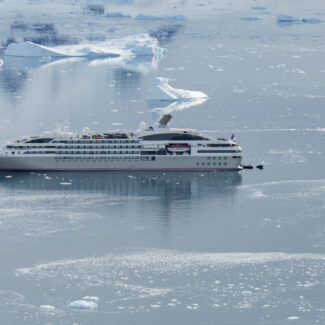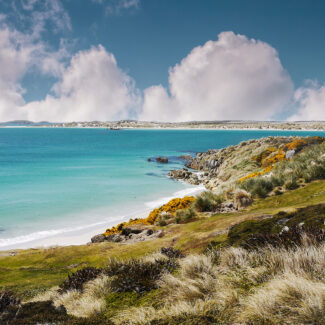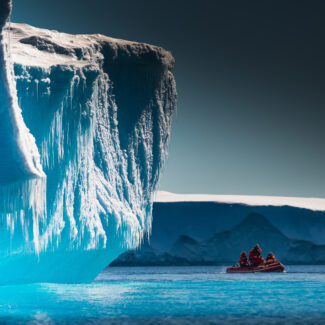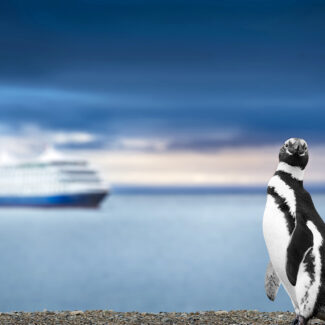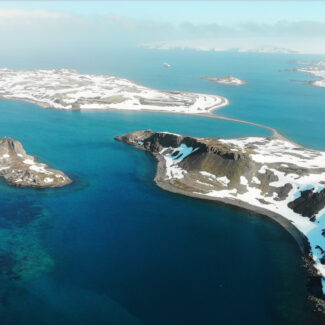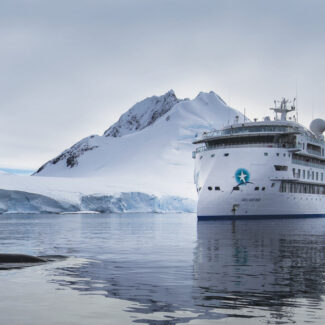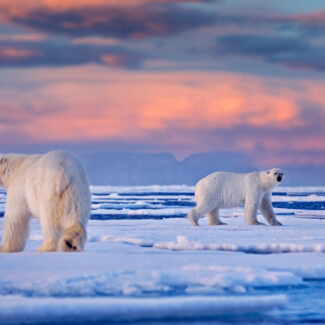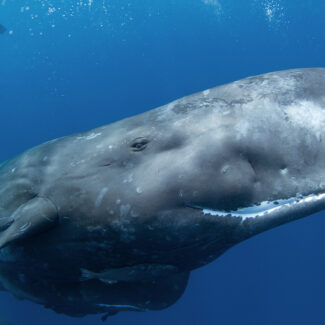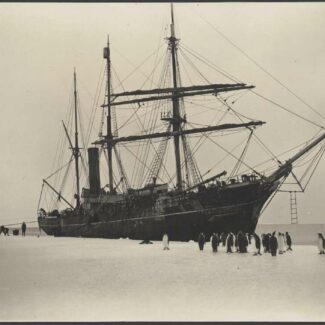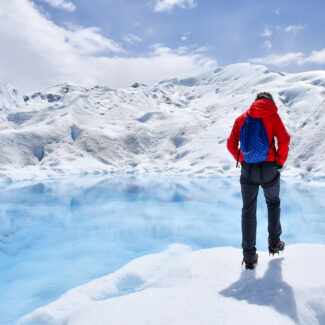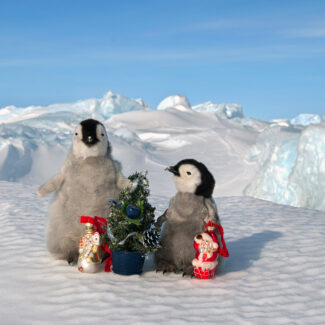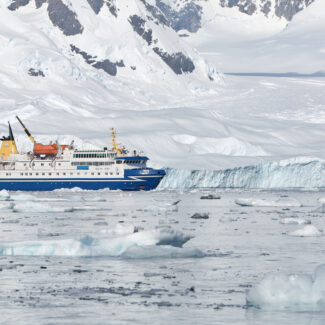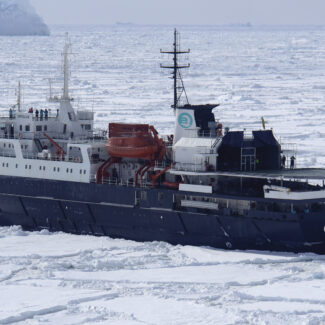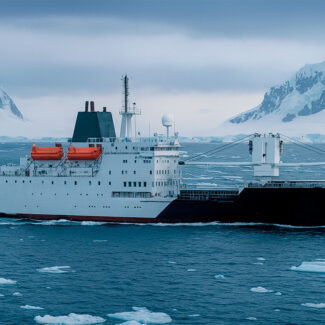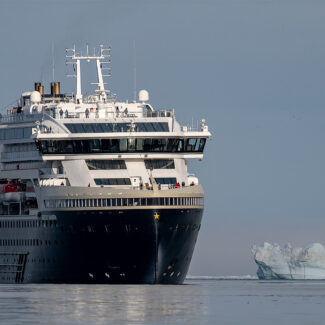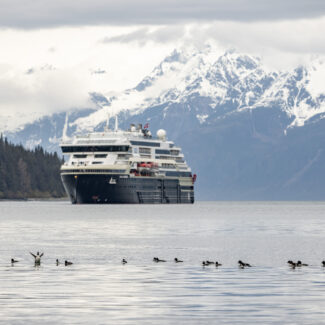7 Fun Facts About Arctic Foxes
- (1) Arctic Foxes Are a Circumpolar Species (and Iceland’s Only Native Land Mammal)
- (2) They Can Travel Far & Wide—and This Helps Explain the Genetic Connectivity of Some Populations
- (3) They’re Perfectly Designed for Cold Weather
- (4) They Come in Two Color Phases & Are the Only Canids to Change Fur Color Seasonally
- (5) They Have a Diverse Diet, Come in Two Main “Ecotypes,” and Will Track Polar Bears to Scavenge Kills
- (6) Arctic Fox Dens Can Be in Operation for a Long Time
- (7) In a Warming Climate, They Face Competition—and Danger—From a Close Cousin
- Where to See Arctic Foxes
If you’re lucky enough to see an Arctic fox in the wild, its daintiness—and cuteness—belie just how hardy this little beast is. After all, it occupies one of the harshest biomes on the planet, enduring frigid temperatures and howling winds, extended seasonal darkness, and a sometimes near-featureless winter domain of frozen-over “wastes.”
A relative newcomer to the mammalian scene—they’re thought to have evolved sometime between the Early to Middle Pleistocene, not all that long ago in evolutionary terms—Arctic foxes are indeed tough buggers that perform an essential role as a midlevel predator and scavenger from sub-Arctic islands to High Arctic wilderness within shouting distance of the North Pole. Read on for seven remarkable yet fun Arctic fox facts, and get to know this amazing critter!
(1) Arctic Foxes Are a Circumpolar Species (and Iceland’s Only Native Land Mammal)
Arctic foxes inhabit a huge range that encompasses not only the Arctic proper but also sub-Arctic areas in places such as the Bering Sea, where, for example, they’re found on Alaska’s Aleutian and Pribilof islands; in Iceland, where they’re the only native land mammal; and in the mountains of Fennoscandia, where unique alpine populations exist. Their domain extends from western Alaska through northern Canada and Greenland to northern Scandinavia—including the Norwegian Arctic archipelago of Svalbard—and Russia.
Their extensive, Arctic-spanning distribution makes them an example, like the polar bear and snowy owl in the Arctic and the Weddell seal in the Antarctic, of a circumpolar species.
What about Arctic fox habitat? Within its vast range, the species typically inhabits tundra environments as well as rocky seacoasts, and ranges far out onto the pack ice in winter. While mainly a creature of wide-open barrens and snowscapes, however, the fox will in southerly parts of its range utilize boreal-forest (aka taiga) habitat.
With their stunning seasonal coat changes, arctic foxes are true survivors of the far north! These resilient creatures are a circumpolar species, thriving in the harsh environments across the Arctic.
(2) They Can Travel Far & Wide—and This Helps Explain the Genetic Connectivity of Some Populations
Pintsized as they are, Arctic foxes are champion long-distance travelers. While they’re territorial during the summer denning season, many populations become essentially nomadic in winter, when they occupy much larger areas and cover a lot more ground than, say, their familiar relative the red fox. Arctic foxes that primarily feed on lemmings may also be compelled to roam widely and seek alternative eats when the numbers of those rodents crash, as happens on a cyclical basis.
Although extensive journeys have been recorded by Arctic foxes traveling overland (including through boreal forest), it’s the Arctic sea ice of winter that affords them their most impressive “runway,” if you will. Foraging foxes will travel long distances on the ice during the wintertime darkness, paying no regard to international boundaries. They’ll regularly cross between Alaska and Russia over the frozen Bering Strait, for example. In 2017 and 2018, a female Arctic fox covered a cumulative 2,485-plus miles ranging between Krossfjorden on Spitsbergen in the Svalbard archipelago to northwestern Greenland. In the space of only about half a year in 2009, two tagged foxes traveled some 1,361 miles and 2,858 miles, respectively, from Nunavut’s Bylot Island on independent wanderings. And in 2019, a young female Arctic fox wearing a GPS collar hoofed it over some 2,700 miles in four months between Svalbard and Ellesmere Island in the Canadian High Arctic, on one day logging nearly 100 miles.
The geographic connectivity afforded by polar sea ice means Arctic foxes in much of the North American Arctic (including Greenland), Siberia, and Svalbard can be considered one continuous population. In contrast, Arctic foxes without access to sea ice—such as those of Alaska’s Pribilof Islands, Russia’s Commander Islands, Iceland, and mainland Scandinavia—are more genetically isolated from other populations.
Don’t let their small size fool you! Arctic foxes are incredible travelers, capable of remarkable journeys across vast icy landscapes. This impressive wanderlust plays a key role in maintaining the genetic health of their populations across the Arctic.
(3) They’re Perfectly Designed for Cold Weather
Arctic foxes are at one end up of the fox-clan bodyform spectrum, with such lower-latitude desert-dwelling kin as the bat-eared fox, fennec fox, white-footed fox, kit fox, and Cape fox occupying the opposite extreme. Whereas those species have outsized ears to help stay cool amid blazing heat, the Arctic fox has small, nubby ears to reduce heat loss. The same goes for its short legs and stubby snout. Indeed, the Arctic fox well illustrates the ecological principle of Allen’s Rule, which describes the different surface-area-to-volume ratios of cold- vs. warm-climate organisms.
The winter coat of the Arctic fox—twice as dense and thick as summer pelage—provides marvelous insulation, as does the body fat it bulks up on in autumn ahead of winter. When hunkering down in the snow, the fox curls in a ball and wraps its luxurious tail around its body: a readymade weatherproof blanket. Uniquely among canids, the footpads of the fox are furred—hence its species name lagopus, which in Greek translates to “hare-foot,” comparing Arctic-fox paws with those of the snowshoe hare. Those footpads have another heat-boosting weapon in the form of countercurrent blood circulation, which maintains fox feet at above-freezing temperatures even when they’re exposed to subzero air and frozen snow and ice.
All of this allows Arctic foxes to flourish in brutal polar weather, making it among the hardiest of terrestrial mammals up here near the top of the world.
Even in the harshest Arctic winters, this cozy arctic fox is perfectly content! Their incredibly dense fur and compact body are just two of the amazing adaptations that allow them to thrive in sub-zero temperatures.
(4) They Come in Two Color Phases & Are the Only Canids to Change Fur Color Seasonally
The resplendent coat of the Arctic fox is fascinating beyond its insulative capabilities. The species comes in two main color phases: white and blue. White foxes are indeed pure white in winter, giving them the perfect Arctic camouflage against the seemingly endless snow- and icescape. Blue foxes are grayish- or brownish-blue. While the white phase is common farther north and in inland zones, blue foxes are more often encountered in coastal and island environments (such as the Aleutians, Pribilofs, and Svalbard), where their darker coat is thought to help them better blend in with seaside rocks and vegetation.
Unique within the dog family, white-phase Arctic foxes undergo a seasonal color change, shifting between that long-haired, snowy-white winter coat and a shorter brown coat with whitish or yellowish flanks and belly in the summer. The change to a summer coat often commences in April, while foxes start turning white again in September or October.
Blue-phase foxes don’t undergo such a dramatic seasonal color swap, typically staying dark year-round—though their thicker winter coat may be a bit lighter in hue. Again, this seems to reflect their predominantly coastal haunts, which may stay largely or partly ice-free even in winter.
Did you know arctic foxes are the only canids that change their fur color with the seasons? This “blue morph” fox showcases one of the two stunning color phases you might encounter, a perfect example of their remarkable adaptation to the Arctic environment.
(5) They Have a Diverse Diet, Come in Two Main “Ecotypes,” and Will Track Polar Bears to Scavenge Kills
Like most foxes, Arctic foxes are mainly hunters of small critters, enthusiastic scavengers, and omnivorous opportunists that won’t pass up the chance to scarf down ripe berries. Rodents such as lemmings (which may compose 90 percent or more of the Arctic-fox diet in some areas), tundra voles, and Arctic ground squirrels are mainstays where available. In coastal areas and on islands lacking such small mammals, nesting birds, their eggs, and their nestlings become important prey—from puffins, auklets, and murres to ducks and geese—with scavenged carrion and beachwrack also significant foodstuffs. Indeed, scientists sometimes roughly classify Arctic foxes into two main ecotypes depending on their ecosystem and main prey base: “lemming foxes” relying heavily on rodents and “coastal foxes” drawing more from avifauna and marine resources.
The spoils of larger carnivores are another important food source. Arctic foxes are well known for trailing polar bears out on the sea ice in order to scavenge their kills: akin to jackals shadowing a pride of lions or clan of spotted hyenas out on the African plains. The foxes certainly also take advantage of wolf-killed caribou and muskoxen. And, in fact, Arctic foxes themselves sometimes set their sights on game larger than lemmings and seabirds: They’ve been known to dig into the snow lairs of ringed seals to snatch pups, and may represent a threat to newborn caribou.
This resourceful arctic fox demonstrates its adaptable nature, even carrying its meal up a rugged slope! Their diverse diet allows them to thrive in the challenging Arctic, sometimes even following polar bears to scavenge their kills and showcasing their incredible survival instincts.
(6) Arctic Fox Dens Can Be in Operation for a Long Time
Mating in March and April, Arctic foxes give birth in early summer—to litters that average about seven kits—within intricate dens they excavate in sandy soil above the permafrost, often in river cutbanks, knolls, or the sinuous ridges of glacial deposits called eskers. Commonly these dens are on south-facing aspects to maximize warmth. In some areas, it’s not uncommon for Arctic foxes to “remodel” existing ground-squirrel warrens for their dens, which often have a number of entrances for heightened security.
These dens can be venerable indeed: Generations of Arctic foxes have been known to use the same lairs for decades or even centuries.
Arctic-fox families tend to disperse by late summer or early fall, and typically mated pairs also go their separate ways for the winter, when the animals pursue what’s largely a solitary existence.
These adorable arctic fox kits emerge from a den that could have been in use for centuries! Passed down through generations, these vital shelters are a testament to the enduring legacy and family bonds of arctic foxes in the wild.
(7) In a Warming Climate, They Face Competition—and Danger—From a Close Cousin
The Arctic is among the fastest-warming places on Earth under our current regime of climate change, and one sign of that shift is the northward expansion of boreal and sub-Arctic creatures into this formerly more inhospitable (to them) realm. One example is a close relative of the Arctic fox: the red fox, the most widely distributed of all the world’s foxes and the largest of the “true foxes” (genus Vulpes).
For some decades now, scientists have wondered about the potential impacts Far North red foxes might have on their littler Arctic cousins, and we’ve gotten some discouraging clues. On Herschel Island in Yukon, where red and Arctic foxes periodically coexist, researchers found that the former tended to den in the most prey-rich areas, potentially excluding Arctic foxes (which happily used former red-fox lairs in years that red foxes didn’t den on the island). And outright interspecific killing has been documented more than once: For example, in 2004, a red fox was filmed running down, killing, and partially consuming an Arctic fox at the Prudhoe Bay oilfield on Alaska’s North Slope.
It’s worth stressing that, as with many polar animals, climate change is likely to affect multiple aspects of the Arctic fox’s environment, including the duration and extent of the sea ice that aids fox foraging in winter and facilitates gene flow and dispersal.
With eyes keenly observing its surroundings, this arctic fox highlights the challenges its species faces in a warming world. As their Arctic home changes, they increasingly encounter competition—and danger—from their larger cousin, the red fox, a stark reminder of climate change’s impact on wildlife.
Where to See Arctic Foxes
You’ve got the opportunity to spy the wiley, resourceful, and (c’mon) outright adorable Arctic fox on cruises to many different destinations, from Greenland and the Canadian Arctic Archipelago to Svalbard, the “wildlife hotspot of the Arctic.” And that holds for any stretch of the typical high-tourism season, with foxes more tied to smaller territories as they rear their kits as compared to their wide-ranging winter habits.
Disclaimer
Our travel guides are for informational purposes only. While we aim to provide accurate and up-to-date information, Antarctica Cruises makes no representations as to the accuracy or completeness of any information in our guides or found by following any link on this site.
Antarctica Cruises cannot and will not accept responsibility for any omissions or inaccuracies, or for any consequences arising therefrom, including any losses, injuries, or damages resulting from the display or use of this information.


